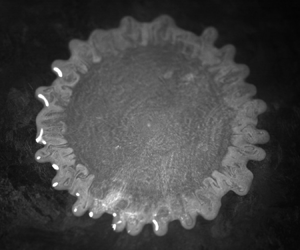Article contents
Role of melting and solidification in the spreading of an impacting water drop
Published online by Cambridge University Press: 03 October 2024
Abstract

The present study reports experiments of water droplets impacting on ice or on a cold metal substrate, with the aim of understanding the effects of liquid solidification or substrate melting on the impingement process. Both liquid and substrate temperatures are varied, as well as the height of fall of the droplet. The dimensionless maximum spreading diameter,  $\beta _m$, is found to increase with both temperatures as well as with the impact velocity. Here
$\beta _m$, is found to increase with both temperatures as well as with the impact velocity. Here  $\beta _m$ is reduced when liquid solidification, which enhances dissipation, is present, whereas fusion, i.e. substrate melting, favours the spreading of the impacting droplet. These observations are rationalized by extending an existing model of effective viscosity, in which phase change alters the size and shape of the developing viscous boundary layer, thereby modifying the value of
$\beta _m$ is reduced when liquid solidification, which enhances dissipation, is present, whereas fusion, i.e. substrate melting, favours the spreading of the impacting droplet. These observations are rationalized by extending an existing model of effective viscosity, in which phase change alters the size and shape of the developing viscous boundary layer, thereby modifying the value of  $\beta _m$. The use of this correction allows us to adapt a scaling recently developed in the context of isothermal drop impacts to propose a law giving the maximum diameter of an impacting water droplet in the presence of melting or solidification. Finally, additional experiments of dimethyl sulfoxide drop impacts onto a cold brass substrate have been performed and are also captured by the proposed modelling, generalizing our results to other fluids.
$\beta _m$. The use of this correction allows us to adapt a scaling recently developed in the context of isothermal drop impacts to propose a law giving the maximum diameter of an impacting water droplet in the presence of melting or solidification. Finally, additional experiments of dimethyl sulfoxide drop impacts onto a cold brass substrate have been performed and are also captured by the proposed modelling, generalizing our results to other fluids.
JFM classification
Information
- Type
- JFM Papers
- Information
- Copyright
- © The Author(s), 2024. Published by Cambridge University Press
References
- 4
- Cited by


